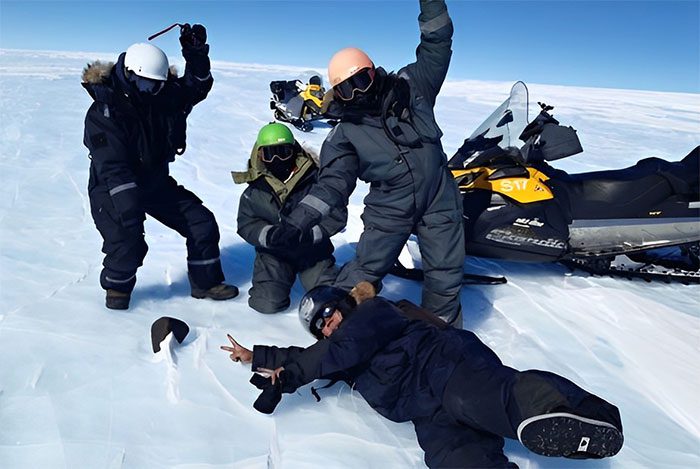Scientists Discover One of the Heaviest Meteorites Ever Found in Antarctica, Along with Four Other Space Rocks That May Have Impacted This Icy Continent Thousands of Years Ago.
Researchers have uncovered a meteorite treasure trove on the surface of the Nils Larsen Ice Shelf near the Princess Elisabeth Station in Antarctica, owned by Belgium. Among the five meteorites, one stands out: a rock the size of a watermelon weighing up to 7.6 kg. Of the 45,000 meteorites discovered in Antarctica, only about 100 are this heavy.

The expedition team poses beside the newly discovered giant meteorite.
Expedition scientist Maria Valdes, a meteorologist at the Field Museum in Chicago, USA, stated: “Size is not an issue when it comes to meteorites, and even tiny meteorites can be extremely valuable scientifically. But of course, finding a large meteorite like this is very rare and truly exciting.”
The meteorites were found on the ice surface in early January and are likely to have been buried in the ice for thousands of years, only surfacing as glacial movements brought them back to the top. Because the meteorites are shielded from rain, wind, and air under the ice, they remain completely intact, according to researchers.
“These objects come from the asteroid belt (located between the orbits of Mars and Jupiter) and likely fell onto the Nils Larsen Ice Shelf in Antarctica tens of thousands of years ago,” said expedition scientist Ryoga Maeda, a PhD candidate at the Free University of Brussels, Belgium, in an interview with Belgian news outlet The Brussels Times.
Typically, scientists must scour glaciers, hoping to stumble upon meteorites. However, researchers were able to narrow down their search area thanks to a study published on January 26, 2022, in the journal Science Advances.
They utilized satellite data and artificial intelligence to identify parts of Antarctica where clusters of meteorites were most likely to be brought to the surface. It was at one of these hotspots that the new meteorites were discovered.
Meteorite samples collected during the expedition have been sent to the Royal Belgian Institute of Natural Sciences in Brussels for proper thawing and analysis. Additionally, each scientist in the expedition has also collected potential meteorite dust samples from around the fallen space rocks, according to a statement.
This is the first expedition to search one of the potential meteorite hotspots marked by the 2022 satellite study. The team’s success indicates that this research could be utilized by other researchers to recover even more frozen meteorite fragments. In the study, researchers estimated that up to 300,000 meteorites could be lying in wait on the ice surface, meaning only about 15% have been found so far.
The expedition team hopes to find more meteorites to help us learn more about Earth.


















































